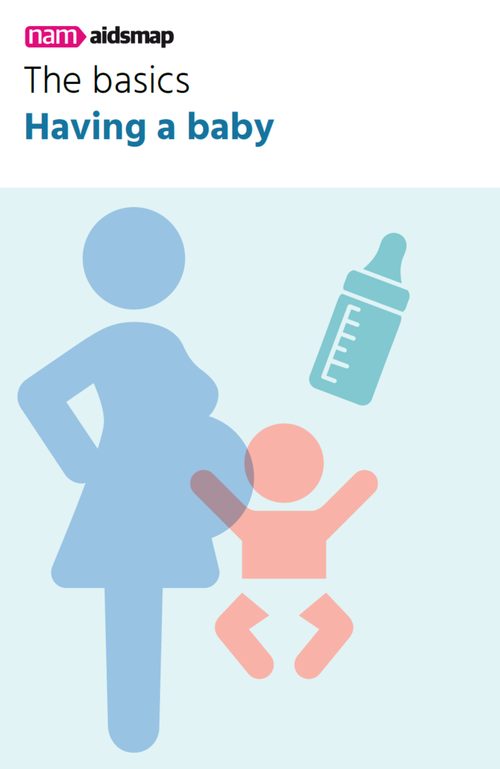
Key points
- Some anti-HIV medications are linked to health problems in pregnancy, including weight gain, diabetes and depression.
- HIV increases the risk of giving birth prematurely, having a baby that is small for the length of pregnancy or a baby with a low birth weight.
- HIV also increases the risk of stillbirth or infant death soon after birth.
- Antiretroviral treatment during pregnancy reduces the risk of these adverse birth outcomes, although the risk remains higher for women living with HIV than for the rest of the population.
- Antiretroviral treatment during pregnancy does not significantly increase the risk of congenital abnormalities, or birth defects.
Adverse maternal health outcomes
Weight gain: Weight gain is a normal feature of pregnancy and in most pregnancies, it does no harm. But for a minority who experience excessive weight gain, it raises the risk of complications of pregnancy including high blood pressure, pre-eclampsia and gestational diabetes. In turn, these maternal complications raise the risk of stillbirth and premature delivery.
Some antiretroviral medications have a stronger association with weight gain than others. A US study found that an antiretroviral combination containing an integrase inhibitor and tenofovir alafenamide (TAF) was associated with a 78% higher risk of excessive weight gain during pregnancy compared to women not taking either drug. (Joseph) Other studies have also found greater weight gain when an integrase inhibitor was combined with TAF. However, studies in Africa have shown that weight gain on integrase inhibitor-based treatment is not excessive. (Eke)
Diabetes: Blood sugar levels can rise during pregnancy, leading to the development of diabetes. Women are at higher risk of gestational diabetes if they are overweight or have obesity, have a South Asian, Black or African Caribbean or Middle Eastern background, or if a close family member has had diabetes. Having HIV does not raise the risk of developing gestational diabetes, but protease inhibitor-based antiretroviral treatment may raise the risk if it is started early in pregnancy. (Soepnel) (Watts)
Raised blood pressure and pre-eclampsia: A slight fall in blood pressure is common during pregnancy. High blood pressure during pregnancy may be a symptom of pre-eclampsia, a condition in which an abnormality in the placenta can harm the health of the mother and unborn child. Pre-eclampsia can lead to stillbirth and low birth weight in the infant and an increased risk of maternal death if blood pressure is not managed carefully during pregnancy.
The major risk factors for pre-eclampsia in pregnancy are untreated high blood pressure, excess weight, age over 35, a first pregnancy, carrying twins or triplets and a previous history of pre-eclampsia. HIV is not a risk factor and a large review of births in one South African province showed that women with HIV on modern antiretroviral treatment had a lower risk of developing high blood pressure than women without HIV. (Slogrove)
Depression: Prolonged low mood and negative thoughts during pregnancy are symptoms of antenatal depression. Depressive symptoms after giving birth are described as postnatal depression. Depression during and after pregnancy is more common in women with HIV. The antiretrovirals efavirenz, dolutegravir and rilpivirine are associated with an increased risk of depression. (Eke)
Adverse pregnancy and birth outcomes
Miscarriage: It is unclear if HIV increases the risk of pregnancy loss. It is difficult to measure the true rate of miscarriage because early pregnancy loss often goes undetected. Studies that have looked at the association between pregnancy loss and taking antiretroviral therapy at the time of conception or during pregnancy do not show consistent results, and more research is needed.
Premature (preterm) birth: Preterm birth is defined as giving birth at less than 37 weeks of pregnancy. Very preterm birth refers to giving birth at less than 34 weeks of pregnancy. Preterm birth has numerous causes including chronic health conditions such as diabetes or high blood pressure.
HIV increases the risk of preterm birth. (Temmerman) Although women with HIV taking antiretroviral treatment remain at higher risk of preterm birth, a meta-analysis of studies showed that antiretroviral treatment reduced the risk of preterm birth compared to no treatment. Some but not all studies have found that antiretroviral treatment also reduces the risk of very preterm birth or spontaneous preterm birth. (Portwood) Treatment with dolutegravir / tenofovir alafenamide/ emtricitabine after week 14 of pregnancy was associated with a significantly lower rate of preterm birth than regimens containing tenofovir disoproxil / emtricitabine plus either dolutegravir or efavirenz in a large randomised study. (Lockman)
British HIV Association guidelines suggest avoiding the use of lopinavir / ritonavir during pregnancy due to a higher risk of preterm birth.
Low birth weight or small for gestational age: A baby is defined as having low birth weight if they weigh less than 2.5kg (5.5lb). A baby is small for gestational age if they are smaller than the usual size for the number of weeks of pregnancy. These outcomes have numerous causes. Living with HIV is associated with an increased risk of having a baby that is small for gestational age or low birth weight. (Wedi) Meta-analyses have produced contradictory findings regarding the impact of maternal antiretroviral treatment on the risk of having a baby that is small for gestational age or of low birth weight. One analysis found that antiretroviral treatment increased the risk of having a baby with a low birth weight, but another analysis found that antiretroviral treatment did not affect the risk of either outcome compared to no treatment. (Cowdell) (Saleska) Another meta-analysis found that protease inhibitor-based treatment increased the risk of having a small-for-gestational age baby when compared to other types of treatment. (Portwood) However, women with HIV on antiretroviral treatment remain at higher risk of having a baby that is small for gestational age, low or very low birth weight compared to women without HIV. (Portwood)
Stillbirth: Stillbirth happens if a baby is born dead in a pregnancy that is well advanced. Stillbirth has numerous causes. Black women, women over 35 and those with diabetes, high blood pressure or obesity are at higher risk of having a stillbirth. Carrying twins or triplets increases the risk, as does a previous pregnancy loss.
Untreated HIV raises the risk of stillbirth. (Wedi) Meta-analysis of all the high-quality studies that have looked at the risk of stillbirth in mothers with HIV shows that women with HIV on antiretroviral treatment do not have a higher risk of stillbirth than women without HIV. (Portwood) Starting treatment during pregnancy does not affect the risk of stillbirth. (Favarato) (Msukwa) Rates of stillbirth have declined with the use of newer antiretroviral regimens. (Eke)
Neonatal death: Neonatal death is death within 28 days of birth. It occurs more often in infants exposed to unsuppressed HIV during gestation or delivery than in the general population. Detectable maternal viral load at delivery, prematurity and congenital abnormalities are the chief risk factors. (Yan) However, if mothers are taking antiretroviral treatment, their infants are not at greater risk of early death than infants born to mothers without HIV. (Portwood) Studies show that neonatal death rates are somewhat higher when antiretroviral treatment includes older drugs such as zidovudine, nevirapine or lopinavir / ritonavir.
Congenital abnormalities (birth defects): Antiretroviral drugs have been investigated to check if there is an increased risk of birth defects associated with any drug used for HIV treatment. Cases of birth defects are reported to registries maintained by the agencies that regulate medicines. Analysis of registries that compile information on antiretroviral drug exposure during pregnancy in Europe and the United States do not show an increased risk of serious birth defects for any antiretroviral drug. (Williams) (Berard) (Martinez de Tejada) Early concerns about an increased risk of neural tube defects if dolutegravir was used around the time of conception and in early pregnancy led to recommendations against its use by women of childbearing potential. Subsequent studies have shown that dolutegravir is not associated with an increased risk of neural tube defects or other congenital abnormalities compared to the general population. (Zash) (Pereira) (Martinez de Tejada)
Impaired growth and development: Studies of infants born to mothers who began dolutegravir or efavirenz-based treatment during pregnancy showed that infants without HIV exposed to efavirenz were more likely to be underweight and experience stunted growth by one year of age. (Stranix-Chabanda) A meta-analysis of studies looking at child development outcomes after exposure to antiretrovirals showed that infants and young children without HIV experienced subtle delays in acquiring language and motor skills by two years of age. (Wedderburn) However, compared to children born to mothers without HIV, the differences were small and there was no evidence that any specific drug was linked to impaired neurodevelopment.
Joseph NT et al. The effect of antiretroviral therapy for the treatment of HIV-1 in pregnancy on gestational weight gain. Clinical Infectious Diseases, 75: 665-72, 2022.
Eke AC et al. Antiretroviral therapy and adverse pregnancy outcomes in people living with HIV. New England Journal of Medicine, 388: 344-56, 2023.
Soepnel L et al. The association between HIV, antiretroviral therapy and gestational diabetes mellitus. AIDS, 31: 113-25, 2017.
Watts DH et al. Maternal toxicity and pregnancy complications in human immunodeficiency virus-infected women receiving antiretroviral therapy. PACTG 316. American Journal of Obstetrics and Gynecology, 190: 506-16, 2004.
Slogrove AL et al. Hypertensive disorders of pregnancy and HIV: analysis of a province-wide cohort during 2018 and 2019. AIDS, published online 8 February 2023.
Temmerman M et al. Maternal human immunodeficiency virus-1 infection and pregnancy outcome. Obstetrics and Gynecology, 83: 495-501, 1994.
Portwood C et al. Adverse perinatal outcomes associated with antiretroviral therapy in women living with HIV: a systematic review and meta-analysis. Frontiers in Medicine, 9: 924593, 2022.
Lockman S et al. Efficacy and safety of dolutegravir with emtricitabine and tenofovir alafenamide fumarate or tenofovir disoproxil fumarate, and efavirenz, emtricitabine, and tenofovir disoproxil fumarate HIV antiretroviral therapy regimens started in pregnancy (IMPAACT 2010/VESTED): a multicentre, open-label, randomised, controlled, phase 3 trial. The Lancet, 397: 1276-1292, April 2021.
Wedi COO et al. Perinatal outcomes associated with maternal HIV infection: a systematic review and meta-analysis. The Lancet HIV, 3: e33-44, 2016.
Cowdell I et al. Adverse perinatal outcomes associated with protease inhibitor-based treatment in pregnant women living with HIV: a systematic review and meta-analysis. eClinical Medicine, 46: 101368, 2022.
Saleska JL et al. Use of antiretroviral therapy during pregnancy and adverse birth outcomes among women living with HIV-1 in low- and middle-income countries: a systematic review. Journal of Acquired Immune Deficiency Sydromes, 79: 1-9, 2018.
Favarato G et al. Stillbirth in women living with HIV delivering in the United Kingdom and Ireland, 2007-2015. Journal of Acquired Immune Deficiency Syndromes, 82: 9-16, 2019.
Msukwa MT et al. Timing of combination of antiretroviral therapy (cART) initiation is not associated with stillbirth among HIV-infected pregnant women in Malawi. Tropical Medicine and International Health, 24: 727-35, 2019.
Yan H et al. Neonatal deaths among infants born to women living with HIV in the UK and Ireland. AIDS, 36: 287-96, 2022
Williams PL et al. Congenital abnormalities and in utero antiretroviral exposure in human immunodeficiency-virus exposed uninfected infants. JAMA Pediatrics, 169: 48-55, 2015.
Berard A et al. Antiretroviral use during pregnancy and the risk of major congenital malformations. AIDS, 25: 2301-4, 2017.
Martinez de Tejada B. Birth defects after exposure to efavirenz-based antiretroviral therapy at conception/first trimester of pregnancy: a multi-cohort analysis. Journal of Acquired Immune Deficiency Syndromes, 80: 316-24, 2019.
Zash R et al. Update on neural tube defects with antiretroviral exposure in the Tsepamo study, Botswana. 24th International AIDS Conference, Montreal, abstract PELBB02, 2022.
Pereira GFM et al. Dolutegravir and pregnancy outcomes in women on antiretroviral therapy in Brazil: a retrospective national cohort study. The Lancet HIV, 8: e33-e41, 2021.
Stranix-Chibanda L et al. Growth of infants with perinatal exposure to maternal DTG vs EFV and TDF vs TAF. Conference on Retroviruses and Opportunistic Infections, abstract 30, 2022.
Wedderburn CJ et al. Early neurodevelopment of HIV-exposed uninfected children in the era of antiretroviral therapy: a systematic review and meta-analysis. Lancet Child & Adolescent Health, published online 25 April 2022

